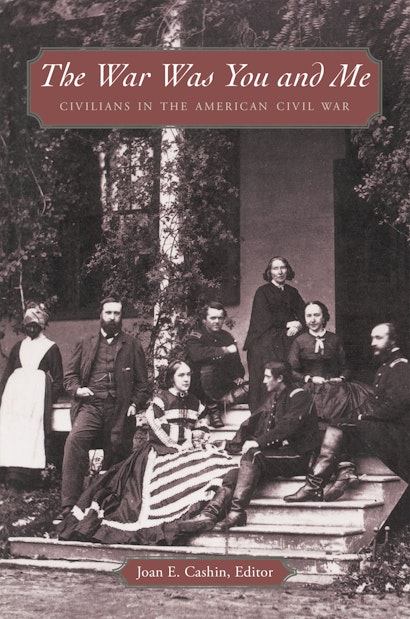Though civilians constituted the majority of the nation’s population and were intimately involved with almost every aspect of the war, we know little about the civilian experience of the Civil War. That experience was inherently dramatic. Southerners lived through the breakup of basic social and economic institutions, including, of course, slavery. Northerners witnessed the reorganization of society to fight the war. And citizens of the border regions grappled with elemental questions of loyalty that reached into the family itself.
These original essays—all commissioned from established scholars, based on archival research, and written for a wide readership—recover the stories of civilians from Natchez to New England. They address the experiences of men, women, and children; of whites, slaves, and free blacks; and of civilians from numerous classes. Not least of these stories are the on-the-ground experiences of slaves seeking emancipation and the actions of white Northerners who resisted the draft. Many of the authors present brand new material, such as the war’s effect on the sounds of daily life and on reading culture. Others examine the war’s premiere events, including the battle of Gettysburg and the Lincoln assassination, from fresh perspectives. Several consider the passionate debate that broke out over how to remember the war, a debate that has persisted into our own time.
In addition to the editor, the contributors are Peter W. Bardaglio, William Blair, W. Fitzhugh Brundage, Margaret S. Creighton, J. Matthew Gallman, Joseph T. Glatthaar, Anthony E. Kaye, Robert Kenzer, Elizabeth D. Leonard, Amy E. Murrell, George C. Rable, Nina Silber, Mark M. Smith, Mary Saracino Zboray, and Ronald J. Zboray. Together they describe the profound transformations in community relations, gender roles, race relations, and culture wrought by the central event in American history.
"A fresh and intriguing text."—Library Journal
"These are fresh topics, written in an engaging style by solid historians, and based on primary sources. . . . Highly recommended."—Choice
"Overall, every essay in this volume is an excellent scholarly contribution to our understanding of the Civil War. Additionally, the volume points the way to new scholarship on the Civil War era, both North and South."—Angela Boswell, Virginia Magazine of History and Biography
"This is a dense and rich tapestry of Civil War civilian life, one that will enrich reigning narratives in the field. Readable, rigorously researched, with ample and diverse articles, this is a must for Civil War scholars and biffs alike."—Lyde Cullen Sizer, H-Net Reviews
"This collection will be of great interest to scholars for its breadth of coverage as well as for the notable strength of the essays' research,
writing, and interpretation."—Margaret M. Storey, Journal of Southern History
"An exceptional collection of original essays that focus on the connections between the front line and the home front. . . . Taken as a whole, they remind readers that the majority of Americans experienced the war out of uniform. Home-front experiences demand our attention if we are to come to a better understanding of the United States' great drama."—Paul A. Cimbala, Journal of American History
"[This book] not only makes a considerable contribution to the field, but it also suggests new ways of approaching wartime social and cultural history. . . . Every essay is well written, admirably researched, and provides not only vital new insights into the civilian home front but also suggests new interdisciplinary boundaries for historical writing on the Civil War."—Silvana R. Siddall, Civil War History
"This excellent collection offers a host of new insights into the impact of the Civil War on civilian life. The essays on subjects ranging from race relations to family life, changes in the role of women, and the war in popular memory, make clear that some of the war's most profound consequences for American history took place away from the battlefield."—Eric Foner, DeWitt Clinton Professor of History, Columbia University
"[This is] an outstanding and very original collection of fifteen essays about the Civil War, including the latest and best scholarship on the North, South, and border states, soldiers and civilians, men and women. Readable and thought provoking, this is a book all students of the Civil War should have in their libraries."—Jean H. Baker, author of The Stevensons of Illinois
"Joan Cashin has assembled a stellar cast of historians to probe different aspects of civilian life during and after the Civil War. The happy result is a collection of essays that brims with innovative questions, new information, and fresh insights."—Michael F. Holt, Corcoran Department of History, Langbourne M. Williams Professor of American History, University of Virginia
"This collection's great strength is that it addresses a subject that has been inexplicably understudied: the impact of war on civilians. The contributors are among the leading younger figures in the field, and the essays are grounded in extensive archival research. They show that the Civil War was just as disruptive on the homefront as it was on the battlefield. "—Steven Mintz, University of Houston
"The collection offers an excellent introduction to an enormously complex story, shedding light on how women and men, black and white, North and South were shaped by—and helped shape—the great sectional bloodletting."—Gary W. Gallagher, John L. Nau III Professor of History, University of Virginia, author of The Confederate War and Lee and His Army in Confederate History

